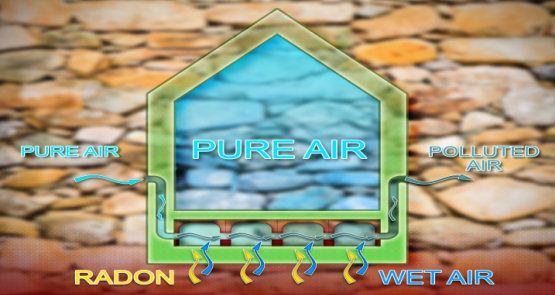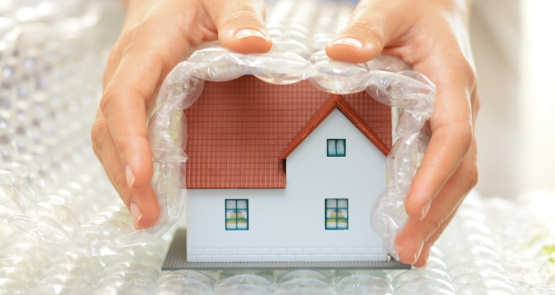Radon Gas Service Covering Plymouth, Devon & Cornwall
Radon Gas is odourless, colourless and it is radioactive. It is created as uranium decays trapped in the ground, soil or rocks. The quantity of Radon gas is conveyed as Bq/m3 as it is measured in Becquerels. In low reading amounts the gas is no threat whatsoever. If the concentrated amount is permitted to rise and accumulate inside the living space of a property it can seriously affect the health of all residents’ occupying the property.
How it can affect you
When the gas levels are high the breathable air inside the property is infected with high levels of radioactive decay products. This is then inhaled and some parts are deposited inside the lungs and whilst there they there still continue to release radiation. This can lead to lung cancer if exposure is maintained over a long period of time.
Growing public concerns
The general public are now becoming more aware as more knowledge is gained a growing concern of the dangers radon gas poses to our health has been adopted. The radon Council is an Independent organization urging that the governments’ current legislation be changed to raise further awareness and increase protection. The acceptable safety levels of Radon gas allowed in dwellings and public buildings were lowered in July 2010 by the (HPA) Health Protection Agency. In 2009 the British Standards for Below Ground Waterproofing amended new changes saying that radon gas needs to be considered when installing and designing a below ground waterproofing system.
Plymouth Damp Proofing (PDP) have the knowledge and knowhow of understanding the effect, behavior, like and dislike of radon gas and with in house trained qualified surveyors and technicians we are the perfect choice to offer you help, advice and recommend a number of remedy solutions to cope with radon for the private, commercial or domestic sectors of the market. We have previous experience includes design & build for new builds, conversions for basements and other types of buildings such as schools, colleges, shops, banks and even office blocks. It is highly imported to ensure that any contractor appointed to attend in the matters of radon levels in a building should be qualified and trained to do so in radon remediation. To install an unsuitable system or incorrectly calibrated system can increase radon levels leading to detrimental effect on health to anyone living or working in the building over time.
Radon services we provide:
- Radon survey & testing via a 3 month & 10 day screening
- Radon level analyzed & recommendation
- Radon mitigation
- Air management units
- Under floor sump systems
- Annual maintenance checks on equipment
- Bi annual radon level testing
- ADD waterproofing systems for basements producing combined waterproofing with radon control


Radon level analyzed & recommendations
Once all data has been analyzed and we are in procession of the results we are in a position to offer you our recommendation for a control method especially designed for your building detailed in our tailor made report. Advice will be offered according to the final results and the recommended radon safety levels published by the HPA. On request we can organize an appointment for a qualified surveyor to attend the building in question so as the design a tailor made suitable fit for purpose remedial system to redirect the gas and the cost implications to do so by the way of a written quotation for a supply and fit installation.
Radon mitigation
We are established in dealing with the issues of radon remediation so the methods we provide are fit for purpose to new builds / dwellings, existing building / dwellings and all types of basements. Included is the Radon ADD waterproofing System that has been specifically designed to battle the damp penetration into basements whilst controlling radon gas levels at the same time. After works have been carried out we offer a after care radon re-test service to verify that the installment works have reduced the amount of radon levels.
Radon testing
The only way to confirm levels or even the presence of radon gas within a building is to complete a test. This is a very simple procedure using radon detectors. The (HPA) Health Protection Agency recommend that reading are recorded over a 3-month period where as screening can be achieved in 10-days. In July 2010 the Health Protection Agency (HPA) recommended that all property owners take action to reduce radon levels above 100 BQ/m3 where as before the recommendations were only to take action if the radon gas levels surpassed 200 Bq/m3.
Further information regarding radon gas can be sourced at the British Geological Survey, Public Health England and of course your local Building Control offices from you local council.
How radon testing works
The detectors used for radon gas are round small black capsules that can easily fit in your palm. The detector contains a CR-39 in the shape of a plastic triangle. Alpha particles invade and impose leaving behind microscopic tracks not visible to the naked eye. We send this information off to our lab where the plastic rectangular CR-39 will be analyzed to enlarge the tracks under a microscope so as the tracks can be counted.
Radon varies in its amounts throughout the day and night peaks and troughs from month to month. As doors and windows are usually open a lot more in the summer month’s radon gas levels are significantly reduced due to the amount of airflow created. However, during the winter months the doors and windows are closed now more of the time, which reduces the amount of air flow trapping radon in resulting in the levels increasing. Due to this when radon levels are calculated the results are passed as annual maximum measurements for that oat the works place in the commercial sector and weighted average measurements for those in the domestic sector. The HPA applies seasonal adjustments depending on the date in the year the test was performed.
The testing process
Once you have contacted us and had a chat with one of our specialist we will send out the correct number of radon detectors for your property. They will be placed in a sealed plastic bag and every tester will have its very own detector number. Once you receive them they need to be kept in their plastic seal bag and when not in use should be stowed in the freezer and kept sealed at all times. Only when you are ready to begin the test should you unseal the bag.
Place the detectors in rooms that are used most regularly like the bedroom, living room, kitchen and if you have a basement that too. Do not place them above a heater or heating device such as a mobile fan heater, fire or especially on a shelve above a radiator.
They need to be around head height, the time and date of the test needs to be recorded as soon as you start the test and also the location and number of each detector. Once the test is completed and after the measurement period place the detectors back into the sealed bag for returning them back to us in the stamped address envelope provided. We will get them to the lab where the radon levels will be calculated. The results we be analyzed by our surveying team who will draft up a report confirming all the information date found, identifying any issues and making and necessary recommendations, should there be a problem.
Mitigation of radon
We care about the health & safety welfare of people living or working in potentially dangerous properties in the commercial and private sectors.
As more awareness is recognized with the concerns of radon gas we have put together a cost effective plan to provide accurate testing, advice and guidance, control and prevention of exposure for the long term. Unfortunately radon gas cannot be prevented or stopped. However, it can be controlled and redirected using the correct methods and solutions as necessary all year from month to month to reach acceptable levels.
New builds
During the construction of a new build an impermeable gas containment barriers can be installed over the foundation and act as a physical barrier to prevent any radon ingress form penetration the foundation. A professional should always install this so as there are no gaps visible also care should be taken not to damage the membrane in any way whatsoever as tears and splits in the fabric will let the gas pass through so the membrane will be unusable as a physical barrier.
Current Building Regulations in certain areas of the UK stipulate that a radon protection system must be included in the design and build of a new construction. This is always changing and being revised and re-written. It will not be long before all new builds to include extensions will all fall into this category to have basic radon protection.
Existing buildings
Under floor sump systems and using air management systems are techniques commonly used in existing buildings to reduce the amount of radon gas levels in existing buildings. If installed correctly they work by altering the air pressure inside the property so as preventing the radon gas levels from accumulating. However, it is of the upmost importance that they are installed correctly as an incorrect installation can lead to radon gas be drawn into the building making the problem 10 times worse.
Basements
Building that has basements are at a greater risk of penetration through the walls from radon gas. As a basement is usually confined, sealed storage spaces with little ventilation the dander is there for radon levels to peak way above the safe recommended limits. However, it is possible to control the radon by installing controlled systems even systems working together such as a sump and pump system or ADD waterproofing system.
Please feel free to contact us for help & advice
If you are concerned about any of the above issues affecting your property, please contact us and a member of our team will be happy to help, as we are Specialists in Property Surveying.
Our Warranty/Guarantee
We are proud to say we take pride in our reputation and how we work. Upon completion of our works you will receive our personal workmanship warrantee along with our guarantee and a manufactures guarantee protected and backed up by the Guarantee Protection Insurance Scheme or (GPI).
We are also looking to become members of the Property Care Association, CHAS, Construction Line and Trust Mark for your peace of mind. All our warranty and guarantees are transferable to new owners of your home if you sell your property.
What lengths of guarantee do we offer?
- Basement water proofing treatments will receive a 10-year guarantee
- All Woodworm treatments, Dry Rot, Wet Rot and Rising Damp will receive a 30-year guarantee
- Timber unit and window treatments will receive a 5-year guarantee
- As an extra on request we can issue an independent insurance backed guarantee


Every case of damp is different and depending on the scale and size of the problem costs to repair will vary. It is important that you have your property surveyed and an individual and specific report completed as soon as possible. Our service gives each customer an individual report with recommendations and quotation to fix the damp problem. To make sure we are giving you an accurate price, one of our surveyors will come to your property to investigate the problem. Once your property has been assessed we will discuss the findings with you and detail the way forward.
Our services we supply in short:
- Damp proofing advice & support
- Damp Surveys
- Basement waterproofing
- Rising damp treatments
- Condensation treatments & control
- Woodworm Treatment
- Wet rot & dry rot treatments
Remember your property is at risk if you let damp set in and do nothing about it!
Please feel free to contact us for further advice
If you are concerned about any of the above issues affecting your property, please contact us and a member of our team will be happy to help, as we are Specialists in Property Surveying.



